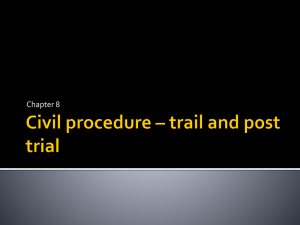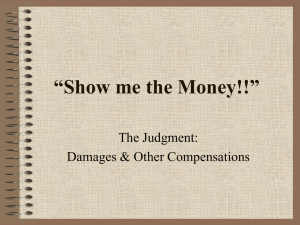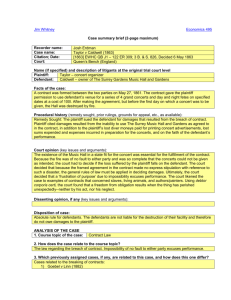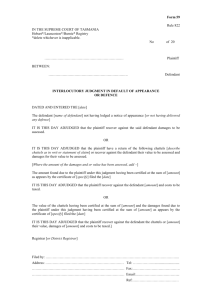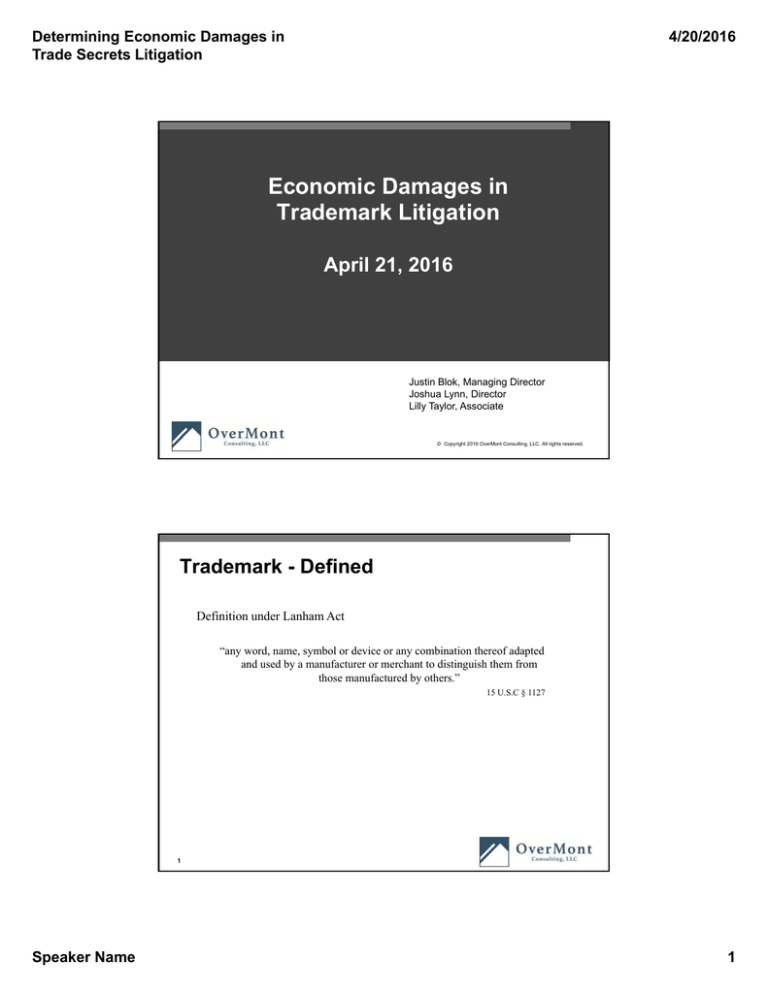
Determining Economic Damages in
Trade Secrets Litigation
4/20/2016
Economic Damages in
Trademark Litigation
April 21, 2016
Justin Blok, Managing Director
Joshua Lynn, Director
Lilly Taylor, Associate
© Copyright 2016 OverMont Consulting, LLC. All rights reserved.
Trademark - Defined
Definition under Lanham Act
“any word, name, symbol or device or any combination thereof adapted
and used by a manufacturer or merchant to distinguish them from
those manufactured by others.”
15 U.S.C § 1127
1
Speaker Name
1
Determining Economic Damages in
Trade Secrets Litigation
4/20/2016
Possible Remedies
1. Injunctive Relief
2. Monetary Relief
2
Injunctive Relief Under the Lanham Act
3
Speaker Name
2
Determining Economic Damages in
Trade Secrets Litigation
4/20/2016
Injunctive Relief
• Injunctive Relief is most common
• Likelihood of confusion
• A finding of infringement may result in an injunction but no monetary
relief (unlike patent infringement)
4
Injunctive Relief – ABPN v. JohnsonPowell
• Dr. Gloria Johnson-Powell claimed on her cv and in expert testimony
that she was ABPN-certified. ABPN requested a preliminary
injunction to keep Dr. Johnson-Powell from infringing its mark. The
court denied the injunction because it believed she was unlikely to
infringe in the future. The court reasoned that ABPN was likely to
prevail on the merits in trial, but it had failed to demonstrate
irreparable harm in the near future.
• Appeals court found that district court had not clearly erred or abused
discretion, noting ABPN would be able to request permanent
injunction.
5
Speaker Name
3
Determining Economic Damages in
Trade Secrets Litigation
4/20/2016
Injunctive Relief – Starter Corp. v.
Converse, Inc.
• Converse and Starter entered into a 1990 Agreement in which Starter agreed
•
•
•
•
not to apply for a trademark for the Starter Star Marks for use on shoes and
sneakers.
In 1995 Starter sought a declaratory judgment that using its Starter Star
Marks on shoes would not infringe the Converse Star Marks. Converse filed
counterclaims, but later withdrew these.
Jury found a likelihood of confusion with regard to the marks on athletic
footwear, that there was a binding contract and that Starter had made oral
representations it would not use its Star marks on athletic shoes.
District Court entered a permanent injunction preventing Starter from use of
its Star marks on any footwear, and related items.
Court of Appeals determined injunction was appropriate, although
counterclaims had been withdrawn, but the scope should match the jury
finding (that is, limited to athletic footwear).
6
Monetary Relief Under the Lanham Act
7
Speaker Name
4
Determining Economic Damages in
Trade Secrets Litigation
4/20/2016
15 U.S.C. § 1117(a)
Monetary Remedies for Trademark Infringement, Unfair Competition, Dilution
(a) Profits; damages and costs; attorney fees
When a violation of any right of the registrant of a mark registered in the Patent and
Trademark Office, a violation under section 1125(a) or (d) of this title, or a willful violation
under section 1125(c) of this title, shall have been established in any civil action arising
under this chapter, the plaintiff shall be entitled, subject to the provisions of sections 1111
and 1114 of this title, and subject to the principles of equity, to recover (1) defendant’s
profits, (2) any damages sustained by the plaintiff, and (3) the costs of the action. The court
shall assess such profits and damages or cause the same to be assessed under its direction.
In assessing profits the plaintiff shall be required to prove defendant’s sales only; defendant
must prove all elements of cost or deduction claimed. In assessing damages the court may
enter judgment, according to the circumstances of the case, for any sum above the amount
found as actual damages, not exceeding three times such amount. If the court shall find that
the amount of the recovery based on profits is either inadequate or excessive the court may
in its discretion enter judgment for such sum as the court shall find to be just, according to
the circumstances of the case. Such sum in either of the above circumstances shall
constitute compensation and not a penalty. The court in exceptional cases may award
reasonable attorney fees to the prevailing party.
8
Remedies Available under Lanham Act
• Plaintiff’s Damages
• Lost Profits of Plaintiff
• Reasonable Royalty
• Corrective Advertising
•
•
•
•
Recovery of Defendant’s Profits
Statutory Damages
Treble Damages
Cost of the Action/Attorney Fees
9
Speaker Name
5
Determining Economic Damages in
Trade Secrets Litigation
4/20/2016
Damages Under the Lanham Act
• General Theory of Damages Under the Lanham Act:
– “…to make violations of the Lanham Act nonprofitable to the infringing
party.”
Otis Clapp & Sons, Inc. v. Filmore Vitamin Co.,
754 F. 2d 738; 225 U.S.P.Q. (BNA) 387
10
Lanham Act Damages Combine Theories of:
COMPENSATION
DETERRENCE
The Common
Law Remedy of
Damages
(Assessing
Profits)
The Equitable
Remedy of
Disgorgement of
Unjust Enrichment
(Assessing
Damages)
11
Speaker Name
6
Determining Economic Damages in
Trade Secrets Litigation
4/20/2016
Remedies Available under Lanham Act
• The court has wide discretion in determining the appropriate remedy
(BASF Corp. v. Old World Trading Co., 41 F.3d 1081, 1092 (7th
Cir.1994)
• “If the court shall find that the amount of the recovery based on profits
is either inadequate or excessive the court may in its discretion enter
judgment for such sum as the court shall find to be just, according to
the circumstances of the case.” (15 U.S.C. § 1117(a))
12
Award of Monetary Damages
• Web Printing Controls Co. v Oxy-Dry Corp., 906 F2d 1202, 1204-05 (7th
Cir. 1990) – Actual confusion not required.
• Taco Cabana Int’l, Inc. v. Two Pesos, Inc., 932 F.2d 1113, 1126-27 (5th Cir.
1991), aff’d, 505 U.S. 763 (1992) – Court affirmed damages even though
plaintiff had not offered evidence of actual diverted sales or customers.
• McClaran v. Plastics Indus., Inc., 97 F.3d 347, 361-62 (9th Cir. 1996) –
Court denied claim for damages because it was speculative to assume
production difficulties would have been resolved.
13
Speaker Name
7
Determining Economic Damages in
Trade Secrets Litigation
4/20/2016
Types of Lost Profits and Related Damages
• Lost Profits on Lost Sales
• Price Erosion
14
Lost Profits on Lost Sales
• In order to receive damages, a plaintiff must generally prove:
– Infringement (a Lanham Act Violation)
– Actual Injury (but lack of actual harm does not preclude award of
defendant’s profits)
15
Speaker Name
8
Determining Economic Damages in
Trade Secrets Litigation
4/20/2016
Lost Profits On Lost Sales
Calculation of plaintiff’s damages is subject to a degree of uncertainty:
“When determining damages in an unfair trade practices case, the courts
distinguish between the amount of proof needed to show ‘that some damages
were the certain result of the wrong’ and the amount of proof needed to ascertain
the exact amount of damage.”
“The plaintiff is held to a lower burden of proof in ascertaining the exact amount
of damages because, ‘the most elementary conceptions of justice and public
policy require that the wrongdoer shall bear the risk of the uncertainty which his
own wrong has created.’ However, the plaintiff may not recover if he fails to
prove that the defendant’s actions caused the claimed harm.”
Otis Clapp & Sons, Inc. v. Filmore Vitamin Co.,
754 F. 2d 738; 225 U.S.P.Q. (BNA) 387 (emphasis added)
16
Lost Profits On Lost Sales
Additional Units Sold
“But For” Wrongful Conduct
x
Price per Unit
Lost Revenues
-
Incremental Costs
Lost Profits
17
Speaker Name
9
Determining Economic Damages in
Trade Secrets Litigation
4/20/2016
Fixed and Incremental Manufacturing Costs
Dollars
Incremental Costs
Total Costs
Fixed Costs
2000
2001
Methods for determining incremental
costs:
Review of variable cost records
Statistical analysis
Engineering study
Account analysis
2002
2003
2004
Methods for allocating common
costs:
Cause and effect
Ability to bear
Benefit received
18
Price Erosion: A Definition
Form of lost profits which may occur if plaintiff reduces its prices
or if price increases are forgone in order to meet competition.
• Generally found in a two supplier market
• Plaintiff is entitled to difference between "but-for" price
(without infringer) and actual price (plaintiff's price during
infringing period)
• Plaintiff can prove by illustrating market events in the period
before, during and after infringer entered the market
19
Speaker Name
10
Determining Economic Damages in
Trade Secrets Litigation
4/20/2016
Price Erosion
• In a Lanham Act case, the plaintiff may claim price erosion if it can
establish that it’s price would have been higher but for the defendant’s
wrongful acts.
– BASF v. Old World Trading Co., 41 F. 3d 1081 – Court denied plaintiff’s
price erosion claim because relevant market had a number of competitors
and pricing had historically represented an important competitive tool.
– Artmark-Chicago, Ltd. v. E. Mishan & Sons Inc. 26 USPQ 2d1201 (DC
N I11 1992) – Court allowed price erosion claim calculated by applying
to the plaintiff’s net profits the ratio of the plaintiff’s but-for price to the
defendant’s actual lower price.
20
Price Erosion:
Pre- and Post-Injunction Damages
"But-For" Price
Expected Price
Actual Price
Date of Injunction
21
Speaker Name
11
Determining Economic Damages in
Trade Secrets Litigation
4/20/2016
"Classical" Price Erosion
PRICE
Key
Plaintiff "but-for"
Plaintiff actual
Infringer
Infringement
Begins
Injunction
TIME
22
Price Erosion
PRICE
Key
Plaintiff "but-for"
Plaintiff actual
Infringer
TIME
Infringement Begins
Injunction
23
Speaker Name
12
Determining Economic Damages in
Trade Secrets Litigation
4/20/2016
Price Erosion
•
•
•
•
•
•
•
Price Declines
Slower/lower price increase
Foregone price increase
Initial prices set too low
Quality improvements without price increases
Accelerated price decline
Bid competition
24
Reasonable Royalty
Sands, Taylor & Wood Co. v. Quaker Oats Co., 978 F.2d 947, 963 (7th
Cir. 1992) – court determined reasonable royalty was a more appropriate
measure of damages than profits; 34 F.3d 1340, 1344 (7th Cir. 1994) –
affirmed award of reasonable royalty
Boston Profession Hockey Association v. Dallas Cap & Emblem
Manufacturing, Inc. 597 F.2d 71, 75-76 (5th Circuit 1979) – court
determined reasonable royalty based in part on amount that defendant had
previously offered to pay plaintiff for license to make cloth emblem of
professional hockey team
25
Speaker Name
13
Determining Economic Damages in
Trade Secrets Litigation
4/20/2016
Reasonable Royalty
• A reasonable royalty may be used in the following
circumstances:
When lost profits are nonexistent or difficult to prove
When defendant has failed to make a profit
When plaintiff has a history of licensing
When “windfall” is a concern
26
Reasonable Royalty
• Royalty damages presume the plaintiff would have granted the
defendant a license to use its trademark, trade dress, etc.
• For example:
• ABC Corp. grants XYZ, Inc. a license to use the ABC Mark in
connection with the sale, offer for sale, or importation of XYZ’s
products.
• In exchange, XYZ agrees to pay ABC a 5% running royalty on all sales
of XYZ’s products in the U.S.
• A “reasonable royalty” is what would have been the negotiated royalty
between a willing licensor/willing licensee at the time of first
infringement.
27
Speaker Name
14
Determining Economic Damages in
Trade Secrets Litigation
4/20/2016
Reasonable Royalty
Example Formula
Revenues from Infringing Product
x
Royalty Rate (%)
Reasonable Royalties
28
Reasonable Royalty
Georgia-Pacific Corp. v. United States Plywood Corp., 318 F. Supp.
1116 (S.D.N.Y. 1970)
• Patent infringement case establishing 15 factors to consider in
determining a reasonable royalty.
• Most factors can be adopted for use in connection with a Lanham Act
violation.
29
Speaker Name
15
Determining Economic Damages in
Trade Secrets Litigation
4/20/2016
Reasonable Royalty
Georgia-Pacific Factors
1.
The royalties received by the patentee for the licensing of the patent in suit,
proving or tending to prove an established royalty.
9.
2.
The rates paid by the licensee for the use of other patents comparable to the
patent in suit.
10. The nature of the patented invention; the character of the commercial
3.
The nature and scope of the license, as exclusive or non-exclusive; or as
restricted or non-restricted in terms of territory or with respect to whom the
manufactured product may be sold.
4.
The licensor's established policy and marketing program to maintain his patent
monopoly by not licensing others to use the invention or by granting licenses
under special conditions designed to preserve that monopoly.
12. The portion of the profit or of the selling price that may be customary in the
The commercial relationship between the licensor and licensee, such as,
whether they are competitors in the same territory in the same line of business;
or whether they are inventor and promoter.
13. The portion of the realizable profit that should be credited to the invention as
The effect of selling the patented specialty in promoting sales of other products
of the licensee; that existing value of the invention to the licensor as a
generator of sales of his non-patented items; and the extent of such derivative
or convoyed sales.
14. The opinion testimony of qualified experts.
5.
6.
7.
The duration of the patent and the term of the license.
8.
The established profitability of the product made under the patent; its
commercial success; and its current popularity.
The utility and advantages of the patent property over the old modes or
devices, if any, that had been used for working out similar results.
embodiment of it as owned and produced by the licensor; and the benefits to
those who have used the invention.
11. The extent to which the infringer has made use of the invention; and any
evidence probative of the value of that use.
particular business or in comparable businesses to allow for the use of the
invention or analogous inventions.
distinguished from non-patented elements, the manufacturing process,
business risks, or significant features or improvements added by the infringer.
15. The amount that a licensor (such as the patentee) and a licensee (such as the
infringer) would have agreed upon (at the time the infringement began) if both
had been reasonably and voluntarily trying to reach an agreement; that is, the
amount which a prudent licensee-- who desired, as a business proposition, to
obtain a license to manufacture and sell a particular article embodying the
patented invention-- would have been willing to pay as a royalty and yet be
able to make a reasonable profit and which amount would have been
acceptable by a prudent patentee who was willing to grant a license.
30
Reasonable Royalty
Comparable License Agreements (Georgia-Pacific Factors 1, 2,
12)—Licensing transactions in the market place for trademarks
comparable to those in suit can prove useful in determining the
structure of a license and royalty rate.
Profit Premium/Analytical Approach (Georgia-Pacific Factor
13)—Additional profits generated as a result of using the
trademark.
For example:
• Product sold with trademark = 35% profit margin;
• Product sold without trademark = 30% profit margin;
• Profits attributable to trademark = (35% - 30%) = 5%.
31
Speaker Name
16
Determining Economic Damages in
Trade Secrets Litigation
4/20/2016
Reasonable Royalty
• Design-Around Costs - Costs and issues infringer would have faced in
order to design and develop comparable technologies/trademarks
without infringement
• Issues include:
Expenses that would be incurred
Time and manpower requirements
Impact of delay of entry to market
32
Corrective Advertising
Defendant may recover the amount needed to spend in “corrective
advertising” to undo the confusion or damage created by infringement of
a mark
33
Speaker Name
17
Determining Economic Damages in
Trade Secrets Litigation
4/20/2016
Corrective Advertising
Big O Tire Dealers, Inc. v. Goodyear Tire & Rubber Company, 561 F.2d
at 1365
• Trademark infringement case where the court said that “dispelling
confusion and deception in the consuming public’s mind does not
require a dollar-for-dollar expenditure.”
• The Appeals Court’s conclusion was to apply the FTC’s 25% Rule for
corrective advertising to Goodyear’s actual advertising expenditures,
pro-rated for states in which Big O competed with Goodyear.
• Enhanced damages also awarded.
34
Corrective Advertising
• U-Haul Int’l, Inc. v. Jartran, Inc., 793 F.2d at 1037 & 1041
• Court awarded plaintiff amount already spent on corrective advertising
plus defendant’s advertising campaign costs.
• U-Haul lost profits also awarded.
• Alpo Petfoods, Inc. v. Ralston Purina Co., 997 F.2d 949, 952 (D.C.
Cir. 1993)
• Past advertising costs may be recovered even if the advertising did not
expressly rebut false or misleading claims made by defendant (award
included difference between plaintiff’s planned and actual advertising
expenditures).
35
Speaker Name
18
Determining Economic Damages in
Trade Secrets Litigation
4/20/2016
Corrective Advertising
Steps in corrective advertising analysis:
1. Determine where the infringing mark was used (e.g., website, on
shelf in store, social media, paid search/banner ad campaigns, etc.)
and for how long;
2. Determine the necessary corrective advertising campaign to correct
consumers’ association with defendant’s product; and
3. Determine costs associated with deploying corrective advertising
campaign.
36
Corrective Advertising
• Punch Clock, Inc. v Smart Software Development, 553 F. Supp 2d
1353 (S.D. Fla. 2008)
• Court awarded plaintiff seven years of corrective advertising at the cost
for Punch Clock to purchase top placement of its website on Google
search listings for the top five keywords associated with the Punch Clock
mark.
• At a cost of $136 per day to purchase keywords for seven years, the
corrective advertising damages totaled $347,480, which the court trebled
to $1,042,440 due to the willful nature of the infringement.
• The court also awarded $100,000 in statutory anticybersquatting
damages.
• Domain name ordered to be transferred to Punch Clock.
• The court also held this to be an “exceptional” case due to the bad faith
and willful nature of SSD’s acts and awarded PCI its attorneys’ fees and
costs.
37
Speaker Name
19
Determining Economic Damages in
Trade Secrets Litigation
4/20/2016
Recovery of Defendant’s Profits
• Plaintiff may not recover damages (such as plaintiff’s lost profits) and
defendant’s lost profits if they are based on the same economic loss
• Courts can increase an award of defendant’s profits, however an
increase must “constitute compensation and not a penalty.”
38
Recovery of Defendant’s Profits
• Venture Tape Corp. v McGillis Glass Warehouse 540 f.3d 56 (1st Cir.
2008) – Venture was awarded McGillis’s estimated lost profits based
on willfulness of infringement. McGillis argued that damage award
overstated harm to Venture because Venture did not attempt to show
actual harm. However, the court found that “when a mark owner
cannot prove actual damages attributable to the infringer’s misconduct
(e.g., specific instances of lost sales), its recover of an equitable share
of the infringer’s profits serves…as a ‘rough measure’ of the likely
harm that the mark owner incurred because of the infringement, while
also preventing the infringer’s unjust enrichment and deterring further
infringement.”
39
Speaker Name
20
Determining Economic Damages in
Trade Secrets Litigation
4/20/2016
Recovery of Defendant’s Profits
Considerations
May require showing willful infringement
Although willful infringement is an important factor, it is not a prerequisite to an
award of defendant’s profits (Quick Technologies, Inc. v. The Sage Group PLC, et al. 313 F.3d 338)
Does not require plaintiff showing actual confusion
Plaintiff must only show defendant’s gross sales
Defendant must provide accounting of costs
Six Factor Test 1
Defendant’s intent to confuse or deceive
Whether sales have been diverted
Adequacy of other remedies
Unreasonable delay by plaintiff in asserting rights
Public interest in making misconduct unprofitable
Whether case of palming off
1. Pebble Beach Co. v. Tour 18 Ltd., 155 F.3d 526, 554 (5th Cir. 1998)
40
Recovery of Defendant’s Profits
Accounting for Profits:
• May be calculated as sales or gross profit
• May be awarded even when no actual profit has occurred
41
Speaker Name
21
Determining Economic Damages in
Trade Secrets Litigation
4/20/2016
Recovery of Defendant’s Profits
• In calculating an accounting for profits, the burden is on the
defendant:
To prove appropriate deduction of costs
To maintain and produce records
To prove a case for apportionment (profits due/not due to alleged action)
42
Recovery of Defendant’s Profits
Tommy Hilfiger Licensing, Inc. v. Goody’s Family Clothing, Inc., 1CV-1934-BBM, U.S. Dist. (D.Ga.2003) – Court denied defendant’s
deduction of certain elements of costs of goods sold because similar
costs “would have been incurred even without the sale of the
prohibited product.”
Bishop v. Equinox International Corp. – Equinox used Bishop’s
“Essence of Life” trademark, and continued to use mark after agreeing
to end use. Bishop did not establish actual losses; an award of
Defendant’s profits was determined by the appeals court to be a
potential remedy. Consideration given to deliberate, willful
infringement and motivation for infringement from economic
weakness of Plaintiff.
43
Speaker Name
22
Determining Economic Damages in
Trade Secrets Litigation
4/20/2016
Recovery of Defendant’s Profits
Gucci America Inc. v. Daffy’s Inc. – Appeals court determined that
while defendant had sold counterfeit trademarked product, the district
court had not abused its discretion in denying plaintiff trademark
holder (a) an accounting of the trademark infringer’s profits, (b) a
recall of the infringing product, and (c) an injunction against future
infringement.
44
Recovery of Defendant’s Profits
• Common types of deductions:
Labor and Material Costs
Advertising Expenses
Operating Expenses
Overhead
• Courts differ on the type of deductions defendant allowed to take as
costs
– Third, Fifth, Seventh and Eleventh Circuits: Only those expenses which
directly relate to the infringing product
– Second, Fourth and Ninth Circuits: Portion of the defendant’s general
expenses, such as overhead, operating expenses, and taxes can also be
deducted
Smith, Gordon V., and Russell L. Parr. Intellectual Property: Valuation, Exploitation, and Infringement Damages, pg. 681.
45
Speaker Name
23
Determining Economic Damages in
Trade Secrets Litigation
4/20/2016
Statutory Damages
• In counterfeiting cases, plaintiff may elect to choose statutory
damages rather than actual damages and profits
• Statutory damages shall not be less than $500 and not more than
$100,000 “per type of good or services sold, offered for sale, or
distributed as the court considers just.”
• $1,000 to $100,000 per infringing domain name under
Anticybersquatting Protection Act (15 U.S.C. 1125d)
• If infringement is willful, plaintiff may not recover statutory damages
of more than $1,000,000 per counterfeit mark.
46
ACPA Damages
• Ticketmaster Corp. v DeVane (E.D.N.C. May 14, 2008) – court
enjoined DeVane from using Ticketmaster or any other confusingly
similar marks in domain names, on websites, in metatags, as
keywords, in email or marketing materials or any other conduct likely
to cause confusion with Ticketmaster. Ticketmaster requested
$10,000 in statutory damages but court awarded $5,000 as “just and
reasonable” based on circumstances of the case of bad faith of
DeVane. Court found this to be an “exceptional” case and awarded
attorney’s fees, citing DeVane’s continued use of domain name after
receiving cease and desist letter, failure to appear in the action and
lack of any rights or legitimate interests in the domain name.
47
Speaker Name
24
Determining Economic Damages in
Trade Secrets Litigation
4/20/2016
ACPA Damages
• Kiva Kitchen & Bath v Capital Distributing No. CIV.A H-06-2562
(S.D. Tex. Apr. 22, 2008) aff’d 5th Cir., Apr. 2, 2009– court awarded
maximum statutory damages of $100,000 for 3 domain names
forwarded to defendants due to direct competition with plaintiff in
Dallas, intentional diversion of customers and defendant’s year-long
refusal to cease its domain-name forwarding. The court awarded
$40,000 for 5 other domain names of plaintiff’s stores due to lack of
direct competition between Kiva and Capital in other markets and
determination that neither retailer sold appliances over the internet.
The court ordered the transfer of the 8 domain names and awarded
attoneys’ fees and costs, and post-judgment interest.
48
Trebling of Damages
• Section 35(a) of the Lanham Act, 15 U.S.C. §1117(a), grants courts
the right to “enter judgment, according to the circumstances of the
case, for any sum above the amount found as actual damages, not to
exceed three times such amount.”
49
Speaker Name
25
Determining Economic Damages in
Trade Secrets Litigation
4/20/2016
Trebling of Damages
•
•
•
•
Mandatory in trademark counterfeiting cases
Awards shall be compensation and not a penalty
Willful ignorance not a defense
Must be intentional in two ways:
Defendant knew goods were counterfeit
Intended to offer goods for sale
50
Trebling of Damages
• H-D Michigan, Inc. v. Biker’s Dream, Inc. WL 697898, 48
U.S.P.Q. 2d 1108 (C.D. Cal. 1998)- plaintiff awarded treble
damages only.
• U.S. Structures, Inc. v. J.P. Structures, Inc., 130 F.3d 1185, 45
U.S.P.Q. 2d 1027 – court awarded treble damages in addition to
actual damages.
51
Speaker Name
26
Determining Economic Damages in
Trade Secrets Litigation
4/20/2016
Attorney's Fees & Costs of Action
• Appropriate for “exceptional” cases
• Plaintiff must show defendant engaged in malicious, fraudulent,
willful and/or intentional misconduct.
• Successful defendant may seek attorney’s fees by demonstrating
the case lacked a good faith basis or was frivolous.
52
Recent Trademark Cases
• Christian Louboutin (“CL”) v. Yves Saint Laurent America (“YSL”),
USDC SD NY
• CL is famous French shoe designer best known for its heels with the
red sole
• Sued YSL claiming damages greater than $1 million over its
monochromatic shoes (specifically those that had red heels)
• Yves challenged trademark – No fashion designer should be able to
monopolize any color
• District Court – Denied a preliminary injunction, stating that
trademark was overly broad; granting trademark protection to the
color red would provide a monopoly over the color that would stifle
creativity of other designers
53
Speaker Name
27
Determining Economic Damages in
Trade Secrets Litigation
4/20/2016
Recent Trademark Cases
• CL v. YSL, Appellate Court:
– Color can be the subject of trademark protection if it acts as a symbol that
distinguishes a product and identifies its source
– Mark was not simply a red outer sole in any circumstance, but a red outer sole
contrasted with a different color on the remainder of the shoe
– Because YSL designed a monochromatic shoe, it could not infringe CL’s mark,
which required a contrast.
- Interesting, CL’s description of the mark in the trademark registration did not
mention the contrast between the outer sole and the shoe
- Court’s response: CL’s shoes have been characterized by their most striking
feature: a bright, lacquered red outsole, which nearly always contrasts sharply
with the color of the rest of the shoe
– Seems Court revised the description of the protectable mark as contained in the
trademark registration to facilitate a compromise: CL could retain exclusive use
of its red sole on a contrastingly colored shoe, while YSL could products its
monochromatic line of shoes
54
Case Study
PODS v. U-Haul
55
Speaker Name
28
Determining Economic Damages in
Trade Secrets Litigation
4/20/2016
“Established in 1998, PODS is making
moving and storage more convenient and
less stressful through its innovative
solution of delivering a level container and
providing the customer all the time they
need to load and unload their container.”
56
57
Speaker Name
http://www.pods.com/
https://www.uhaul.com/; https://web.archive.org/web/20121231202443/http://www.uhaul.com/ubox/
29
Determining Economic Damages in
Trade Secrets Litigation
4/20/2016
Google Search for “moving pods”
PODS
U-Haul U-Box
58
PODS v. U-Haul Jury Verdict
Liability
• Likelihood of confusion (federal and common law trademark
infringement)
• Unfair competition (federal and common law)
• Trademark dilution (federal and state)
• Violation of Florida Deceptive and Unfair Trade Practices Act (i.e.,
because of trademark infringement or unfair competition)
• Unjust enrichment through use of “pod” or “pods”
59
Speaker Name
30
Determining Economic Damages in
Trade Secrets Litigation
4/20/2016
PODS v. U-Haul Jury Verdict Form
Actual Damages
Experts testified at trial that PODS was entitled to corrective advertising
damages, consisting of an Internet paid search campaign to counteract
“misimpressions” on U-Haul’s website.
60
PODS v. U-Haul Jury Verdict Form
Unjust Enrichment
Expert testified at trial that U-Haul generated incremental profits from UBox container rentals.
61
Speaker Name
31
Determining Economic Damages in
Trade Secrets Litigation
4/20/2016
PODS v. U-Haul
Court Order Entering Injunction
62
U-Haul Website as of Apr. 20, 2016
63
Speaker Name
https://www.uhaul.com/
32
Determining Economic Damages in
Trade Secrets Litigation
4/20/2016
Justin Blok
Joshua Lynn
Lilly Taylor
OverMont Consulting, LLC
3100 Weslayan, Suite 340
Houston, Texas 77027
(713) 590-2850
64
Speaker Name
33

